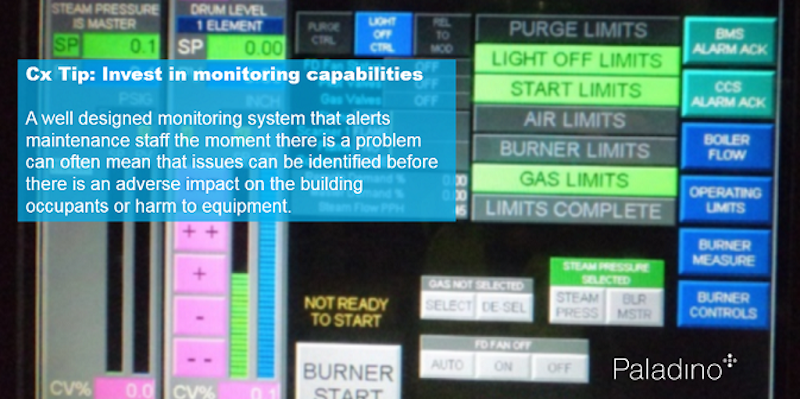Commissioning helps projects achieve greater occupant comfort and satisfaction, higher building energy efficiency, and ensures ease of maintenance for the building engineering staff.
Ultimately, commissioning is where the rubber meets the road in terms of building design. Commissioning a building is how an owner is able to have full confidence that the building is operating as designed and that we aren’t wasting a single dollar on inefficient systems.
Paladino and Company has managed hundreds of commissioning projects including office, hotel, multifamily, schools, and retail; and I have had the opportunity to resolve a range of issues that come along with each opportunity.
I can’t distill everything that we’ve learned, but I can share the common themes and some smart ideas to mitigate typical challenges.
1. The devil is in the details

With mechanical systems commissioning, the contractor’s focus is often on ensuring that all systems meet their basic purpose, which is to provide conditioned air to the space. What often gets overlooked are the details that may not affect occupant comfort. Consider, for example, systems that provide ventilation that are not working properly. Or something causing a system to use more energy than needed, such as if the schedules are set improperly or if a damper is not functioning. Or components that are intended to prevent or detect failures, such as alarms that are not set up or a leak detector that’s not operating. These are all examples of issues that may not be detected by the end user but will absolutely impact cost and performance.
2. Design for the maintenance team as well as building occupants

Developers and architects often provide as much usable space as possible in the design, without locating mechanical systems in a place that makes maintenance easy. We have seen mechanical units placed above 12-foot-high ceilings with another 8 feet of space between the ceiling and the units. Even a simple task such as changing a filter becomes time consuming, and service on the unit becomes very difficult. When maintenance is difficult, it is less likely that it gets done. Design space so mechanical units can be easily accessed. A smart design saves a lot of time and headache for the operations staff, and improves the maintenance and performance over time.
3. Don’t skip monitoring capabilities
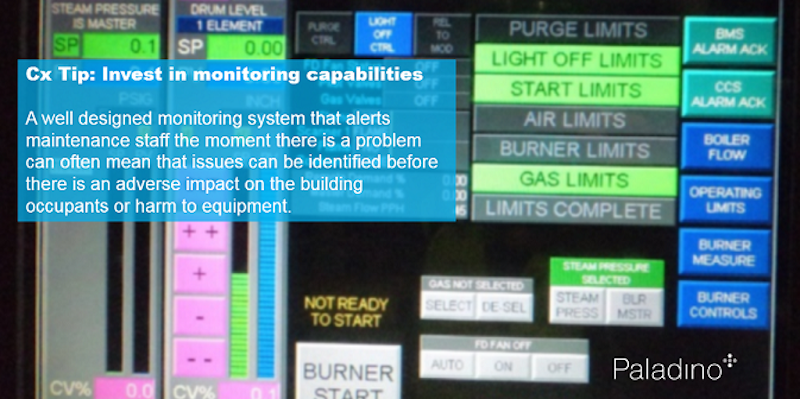
Building engineers have strong feelings about the monitoring capability of their HVAC systems (or lack thereof). A well designed monitoring system that alerts maintenance staff the moment there is a problem can often mean that issues can be identified before there is an adverse impact on the building occupants or harm to equipment. We provide a monitoring and reporting solution called Clarity that has had remarkable ROI – if your building isn’t actively monitored, money could be wasted right now.
4. What you don’t know could cost you
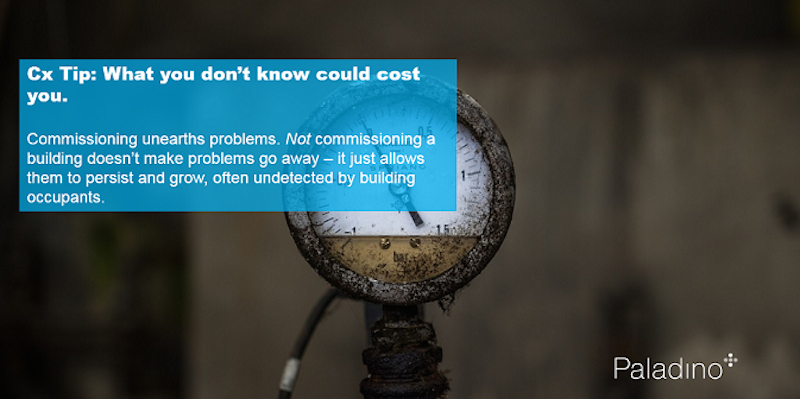
Commissioning unearths problems. Not commissioning a building doesn’t make problems go away – it just allows them to persist and grow, often undetected by building occupants. And the longer the building goes uncommissioned, the more the issues will pile up, creating a big and potentially expensive problem. If your building is using more energy than necessary, has insufficient indoor air quality, or potential safety hazards, you want to know about it sooner rather than later. Property owners should retro-commission their un-commissioned buildings, and do it ASAP. CapEx budgeting season is the perfect time to get bids from commissioning vendors.
5. Enhanced commissioning prevents design headaches
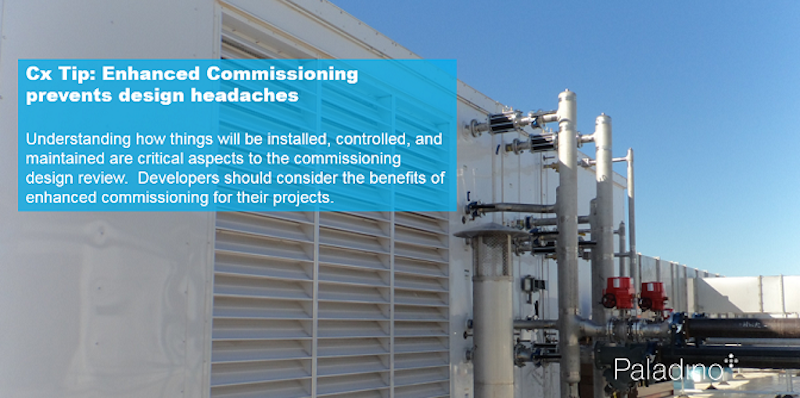
Paladino commissions projects with both fundamental and enhanced commissioning. Possibly the best benefit of enhanced commissioning is the commissioning authority’s design reviews. When a project that only had fundamental commissioning reaches the construction and closeout phases, there are often issues that could have been avoided had we had the chance to review the design and provide feedback to the engineering design consultants. The CxA can use past experiences in the field to identify potential issues in the design. Understanding how things will be installed, controlled, and maintained are critical aspects to the commissioning design review. Developers should consider the benefits of enhanced commissioning for their projects.
6. Let the design engineer and CxA resolve issues with controls
Control systems can be problematic on complicated projects. The issues usually result from controls contractors designing systems around their own opinions or interpretations. A thorough review of the controls submittal’s sequences of operation, schematics, and wiring diagrams by the design engineer and CxA – and coordination between all parties – will resolve issues and establish a mutual understanding about how the systems will be operated.
7. Test procedures should be reviewed by the persons conducting the tests
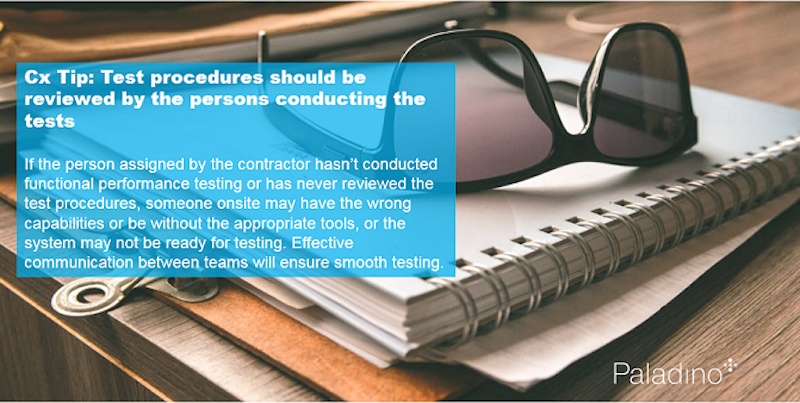
It is not uncommon that the person assigned by the contractor to conduct functional performance testing has never reviewed the test procedures, which can lead to having someone onsite with the wrong capabilities or without the appropriate tools, or the system is not fully ready for testing. Effective communication between teams will ensure smooth testing.
More from Author
Paladino | Jan 10, 2022
The future of regenerative building is performance-based
Why measuring performance results is so critical, but also easier said than done.
Paladino | May 26, 2021
Injecting embodied carbon capability into the integrated design and construction process
Embodied carbon is defined as the carbon footprint of a material, and is expressed in metric tons of CO2e.
Paladino | May 12, 2021
Climate modeling for a resilient business and future
This post explores changes that developers and their teams need to make to their risk and resilience strategies by climate modeling for climate change.
Paladino | Apr 26, 2021
Building performance requirements are coming: Are you ready?
Building Performance Requirements are trending nationwide and are likely coming to a county near you.
Paladino | Feb 8, 2021
Six lessons learned from our first Fitwel Viral Response Module certification
The Fitwel Viral Response Module is one of several frameworks that real estate owners and operators can use to obtain third-party certification for their efforts ensuring their properties are ready for a safer and healthier return to work.
Paladino | Jan 14, 2021
Shift your energy to carbon
Now is the right and necessary time for the commercial real estate industry to shift its environmental strategy from just energy, a carbon contributor, to carbon itself.
Paladino | Nov 13, 2020
5 tips when designing for daylight
Daylight modeling is a tool to examine how daylight interacts with a building, and how that natural light behaves within interior spaces.
Paladino | Jul 16, 2020
COVID readiness: IWBI and USGBC seek to help businesses quantify risk
In an effort to address the risks of COVID-19 at the building scale, USGBC and IWBI have analyzed existing certification guidelines and drafted new, relevant content.
Paladino | Jun 5, 2020
3 strategies to improve the wellness of building systems and gain tenant trust
Three operational issues that must be prioritized for every building in order to achieve tenant trust are air quality/ventilation, relative humidity, and building commissioning.

